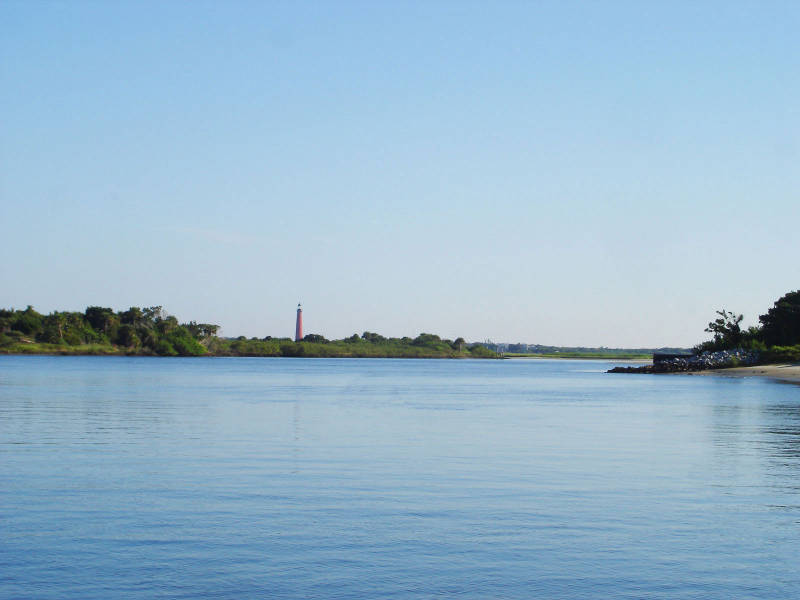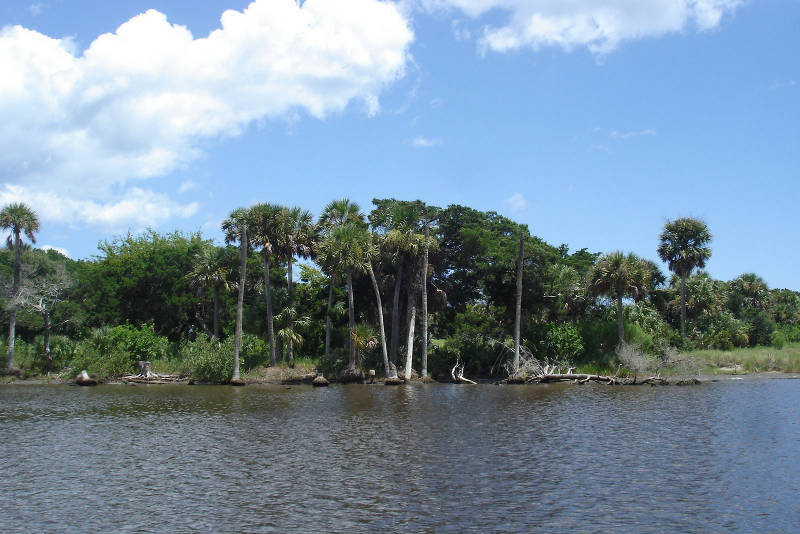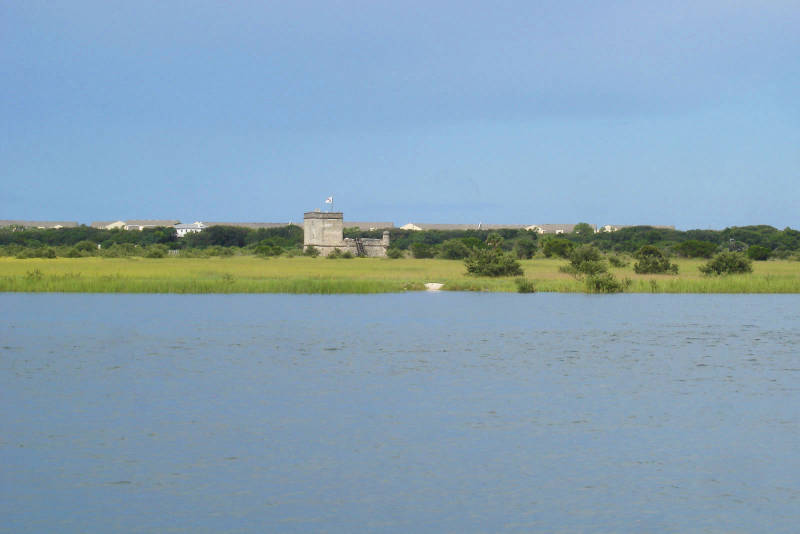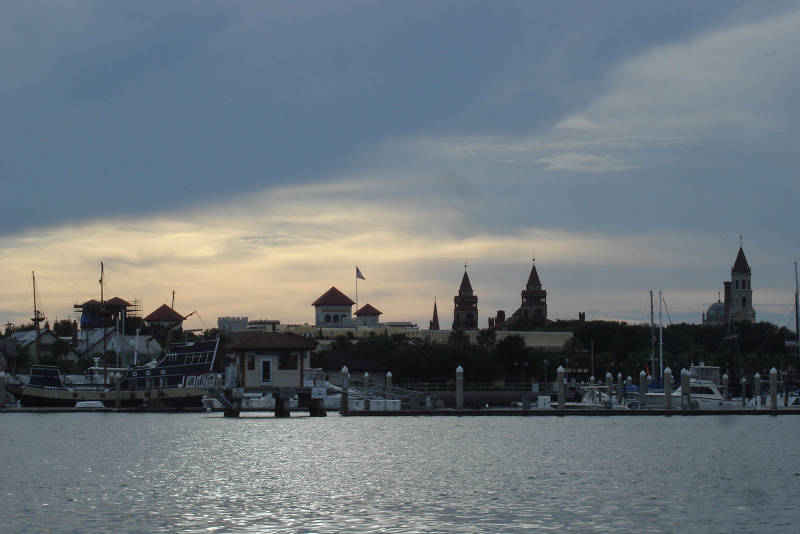
By Chuck Meide, Director of the Lighthouse Archaeological Maritime Program - Lighthouse Archaeological Maritime Program
August 18, 2014

Roper cruises past the Ponce Inlet Lighthouse on the Intracoastal Waterway, which affords up breathtaking views on our final voyage home. Image courtesy of Image courtesy of the Search for the Lost French Fleet of 1565 Expedition, NOAA-OER/St. Augustine Lighthouse & Museum. Download larger version (jpg, 199 KB).
I have spent the last 12 days at sea on board the Roper, on both Cruise 2 and Cruise 3. While it has been a joy to work on this project, and with such a great team, I’d be lying if I told you I wasn’t ready to take a break after living and working in such cramped conditions. Hauling anchors up and down, diving to the bottom to manhandle probes, and being almost constantly wet will exhaust you, especially after 12 days. But I know after a few days back on shore I will miss it out here!

As we cruise north on the Intercoastal Waterway, we pass stretches of undeveloped Florida wilderness, and get a glimpse of Florida the way it once was seen by the Frenchmen seeking a new life here. Image courtesy of Image courtesy of the Search for the Lost French Fleet of 1565 Expedition, NOAA-OER/St. Augustine Lighthouse & Museum. Download larger version (jpg, 373 KB).
We have seen spectacular views. I live only a few blocks from the Atlantic Ocean, but it is amazing the difference it is to actually live afloat on the ocean. Out here we see the full scope of the sky, all the time. Every day we witnessed wondrous and breathtaking things, from sunsets to moonrises to oncoming storms to sunrises.
When gazing at the shore, we hear the crashing of surf on sand and without the condos and hotels that are ubiquitous on most Florida beaches. You can really imagine what it might have been like when the French were shipwrecked here 450 years ago. We have eaten fresh-caught fish and been rocked gently—and not so gently—to sleep.
And the entire time we have been here, we have been doing something that no one has done before us—searching this desolate stretch of coastline for the remains of the long lost French fleet. They crashed here in a tremendous storm so long ago, and the bones of their ships must lie somewhere in this area. It has been a long-term dream of mine to mount a search for these ships, the holy grail of maritime archaeology in Florida, and just to be out here is a dream come true.
Even if we did not find them this year.
That thought, that bit of gloom pervading an otherwise beautiful day, has been on my mind and that of my crew. We knew it was a long shot. To find any shipwreck from half a century ago is a long shot, and especially one that wrecked on the Atlantic Coast, exposed as it is to the full brunt of storms for all those years. We don’t know if our wrecks were right under our feet, but buried more deeply than our probe, or if those wrecks are in the surf zone just out of reach of Roper’s safe operating area, or if those wrecks might be located just outside our survey area. But at least we made the attempt. At least we were out here, giving it our best shot.

Here is the view of Fort Matanzas as we cruise past it. This fort was built by the Spanish in 1742 to guard the “back door” to St. Augustine, the Matanzas Inlet. This approximate location is where, in 1565, the shipwrecked French survivors met Spanish forces and surrendered, and were subsequently massacred. Matanzas means “slaughters” in Spanish. Image courtesy of Image courtesy of the Search for the Lost French Fleet of 1565 Expedition, NOAA-OER/St. Augustine Lighthouse & Museum. Download larger version (jpg, 148 KB).
And it was a great team effort, and a successful project carried out in adverse field conditions. We surveyed a total of 175 linear miles, the entire planned search area that our boat could safely access. We finished the survey despite weather days and equipment problems by working long hours, in one case over 19 hours. We probed around 300 holes in the seafloor over 57 dives, without a single safety incident. We worked hard and we worked as a team. No project director could ask more of a team.
I think these things as we cruise home along the Intracoastal Waterway. This route is safer but longer, but we felt we didn’t need to push things after a long, hard project. During the voyage, we all take hour shifts driving, and it's not so bad at all, even when we run through a storm which eliminated most visibility.
After a full day of transit, we finally begin to see familiar landmarks. First, we see the 312 Bridge on the horizon, one of St. Augustine’s two bridges to Anastasia Island, our final destination. Then we see the Lighthouse itself, a sight for sore eyes that to us, as to generations of St. Augustine mariners before us, means home.
Finally, we cruise past the familiar skyline of St. Augustine, with the historic and not-so-historic ships in the harbor, the silhouette of towers and spires built by Henry Flagler at the height of the Gilded Age, and the outline of the Bridge of Lions. We cruise under it and past the seventeenth-century Castillo de San Marcos into Salt Run, and finally to the dock where we tie up Roper for unloading.

The sun sets behind St. Augustine as we finally reach our destination, passing the unique skyline of this most beautiful and ancient of cities. St. Augustine was founded in 1565, once the Spanish eliminated the threat of the French at Fort Caroline, and has thrived ever since, making it the oldest port in the United States. Image courtesy of Image courtesy of the Search for the Lost French Fleet of 1565 Expedition, NOAA-OER/St. Augustine Lighthouse & Museum. Download larger version (jpg, 206 KB).
To my surprise, almost the entire shorebound crew has come out to greet us, and they have brought a truck and trailer to help us unload all of the equipment that has served us so well out at sea. Our students and volunteers, who worked faithfully behind the scenes to help us by shopping and cleaning equipment and loading gear, have shown up for our final arrival, to pitch in one last time.
Many hands make light work and we empty the boat out relatively quickly. Afterwards, we all retire to the nearest pub to grab a bite to eat and share some pints as we swap sea stories and laugh at all the problems we overcame, and struggle to get our land legs back again.
We forget the disappointment of not finding our wrecks and replace it with enthusiasm as we talk about the possibilities of returning next year to finish testing another dozen or so potential targets.
Everyone is eager, excited, enthused. No project director could ask for a better crew.